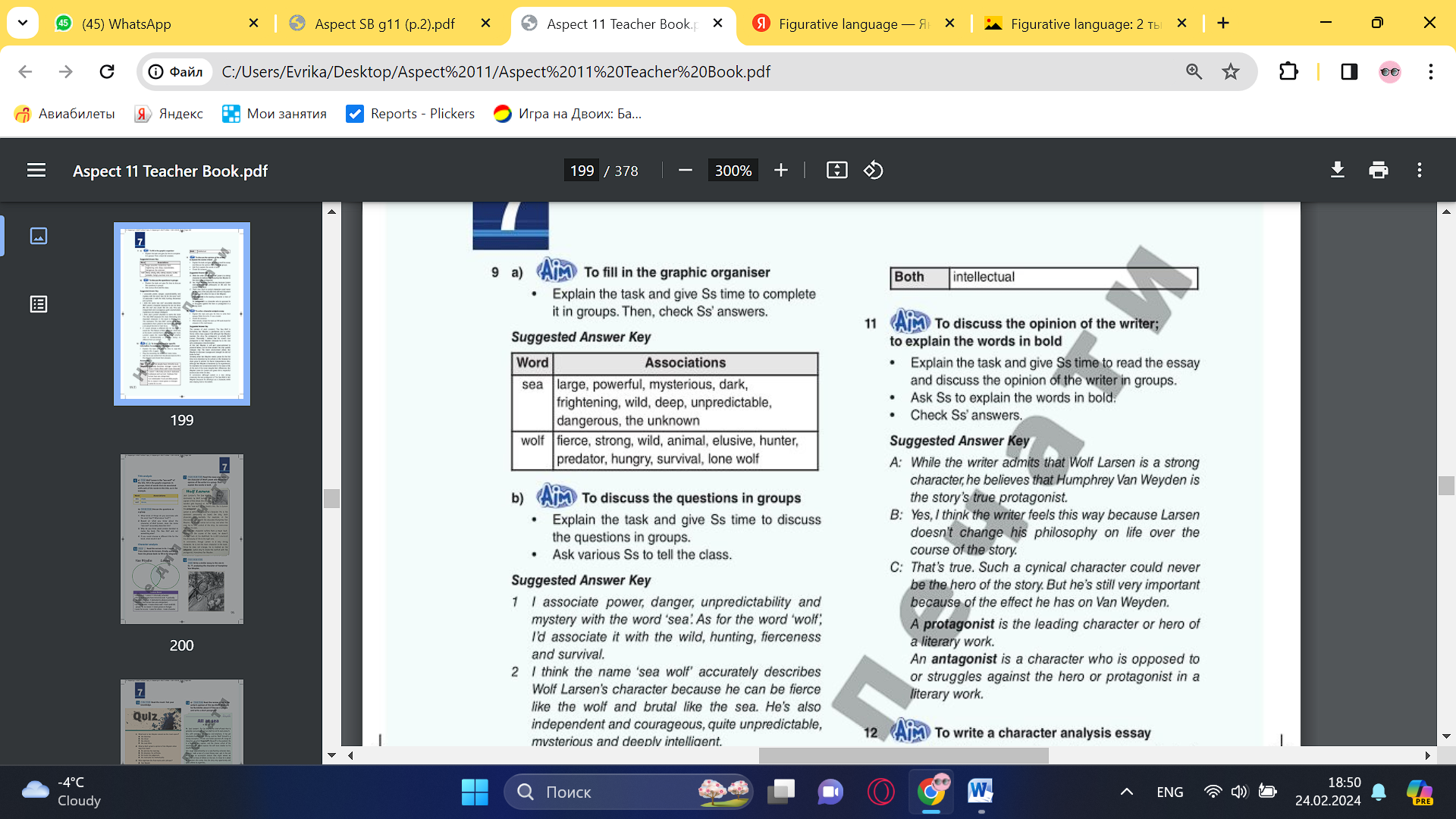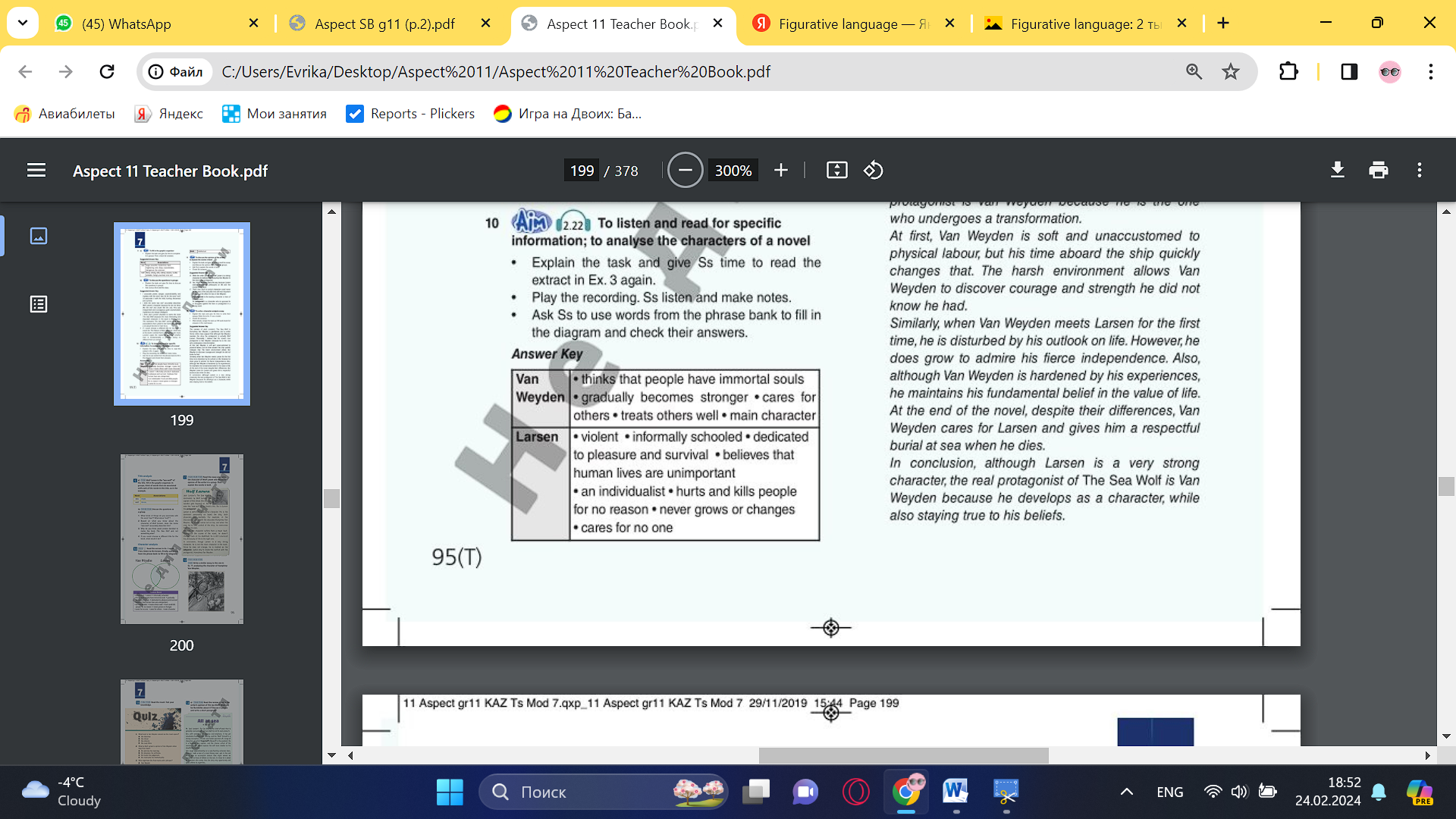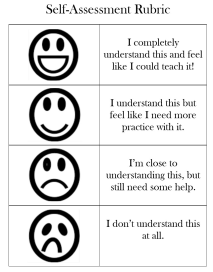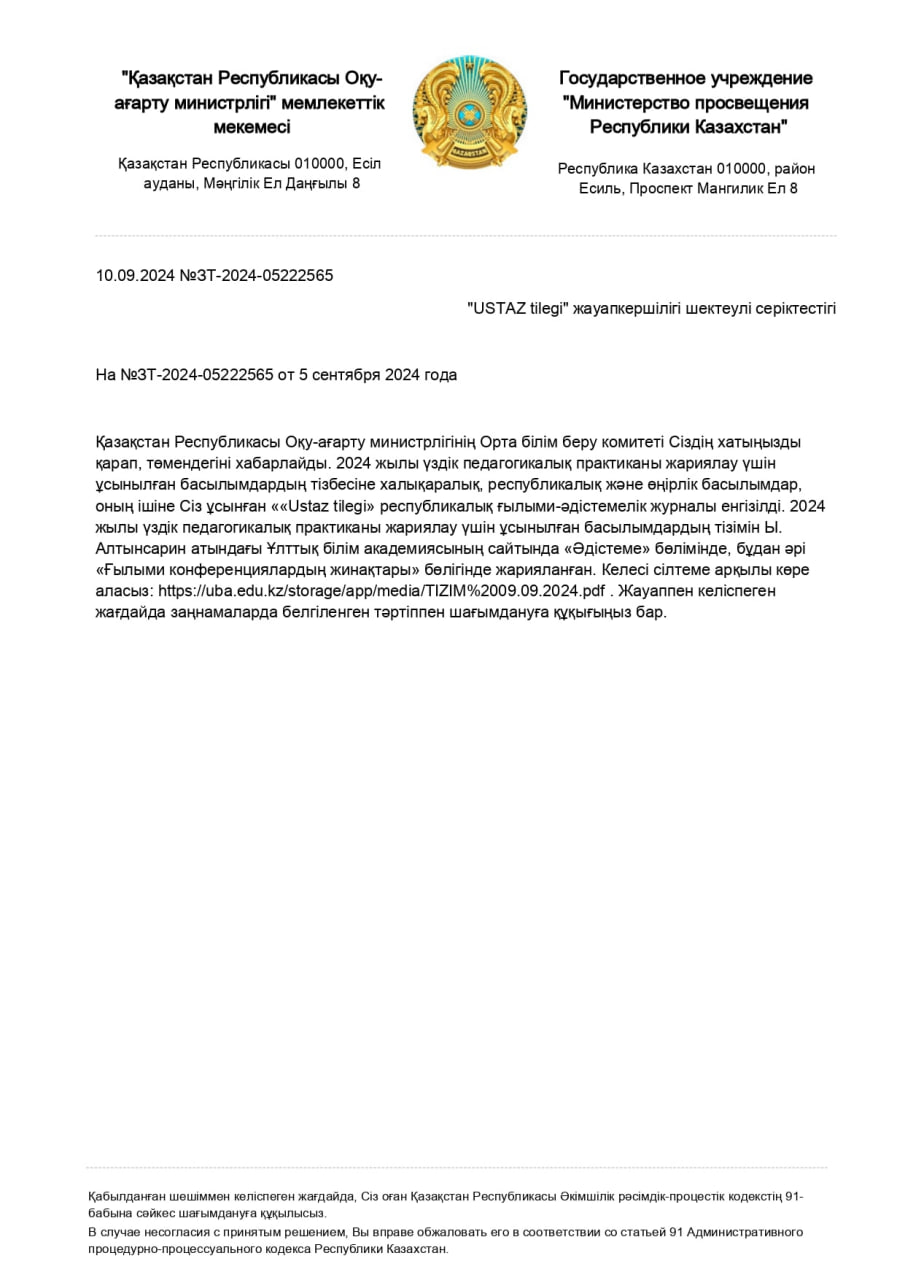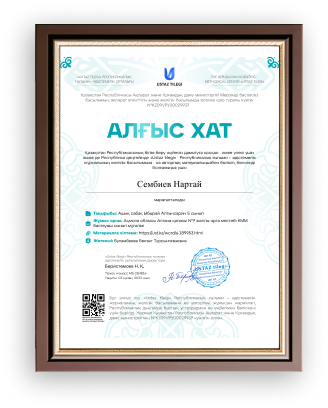
|
Unit 7 Reading for pleasure |
Lesson 75 |
||
|
Teacher name: |
|
||
|
Date: |
|
||
|
Grade: 11 |
Number present: |
absent: |
|
|
Lesson title |
Genres of fiction |
||
|
Learning objectives |
11.1.10.1 - use talk or writing as a means of reflecting on and exploring a range of perspectives on the world topics, including talk on a growing range of unfamiliar topics 11.2.4.1 - understand implied meaning in unsupported extended talk on a wide range of general and curricular topics, including talk on a growing range of unfamiliar topics 11.3. 3.1 - explain and justify own and others’ point of view on a range of general and curricular topics, including some unfamiliar topics |
||
|
Lesson objectives |
Learners will be able to: -introduce the topic; to read for gist -expand on the topic |
||
|
Value links |
Fairness – If you value fairness, you might be highly sensitive to situations at school or in the workplace where a teacher or a peer has exhibited favoritism or allowed someone to get away with living by a different set of rules to everyone else. |
||
|
Plan |
|||
|
Stages / Time |
Teachers actions |
Students actions |
Assessment criteria |
Resources |
|
Beginning of the lesson Warming-up 3 min Pre-learning «Brainstorming» method 7 min. |
Organization moment : 1.Greeting. Ask about the weather. The teacher sets the lesson objectives, letting students know what to anticipate from the lesson.
revise the vocabulary from the previous Lead – In.
|
. The aim: To develop pupils speaking skills and create friendly atmosphere Efficiency: By wishing each other they feel better and feel the support of others Students of the class are listed. Students' attention is drawn to the lesson. • Learners remember previous lesson vocabulary Determines the topic and purpose of the lesson Students say different words from the picture |
The teacher to assess learners for their ability. “Good job! Well done!” Formative Assessment
Good job! Descriptor: - can tell the time Point 1 Assessment criteria - Learners have met the learning objectives if they can talk about |
Pictures worksheet Picture |
|
Middle of the lesson Presentation part. 30 min |
Ex: 1 P: 91 ● Read the different genres aloud and elicit from Ss what kind of fiction they think each one represents (e.g. What kind of characters would you expect to find in a fantasy novel? What kind of plot do adventure novels usually follow?). Explain the meaning of any unknown genres or ask Ss to look them up in their dictionaries. Give Ss time to read the extracts and match them to the genres. Ask Ss to justify and compare their answers in groups. Check Ss' answers around the class. Ex: 2 P: 91 ● Ask Ss to work in groups to match the extracts with the books. Remind Ss to justify their answers. Ask Ss to use the Internet to check their own answers. Ask Ss if they have read or heard of any of the books and elicit discussion around the class. Conclusion during the lesson some tasks differentiated by outcomes of the students and by their abilities. |
•Pupils read the extract and match then to the genres. Compare answers in a group. ANSWERS 1 E 2 B 3 F 4 C 5 A 6 D •Pupils work in groups. Match the extract with the books below. Answer the question. ANSWERS 1 d 2 c 3 b 4 e 5 a 6 f |
Descriptor: - read the extract - match then to the genres Total: 2 point
Self assessment Descriptor: - work in groups - match the extract with the books Total: 2 point -Make CCQ questions Yes / No Total: 1 point Total: 10 point |
Card Worksheet |
|
End of the lesson 5 min |
FEEDBACK Learners provide feedback on what they have learned at the lesson. Ex: Home task: |
|
Poster Success
|
|
|
Unit 7 Reading for pleasure |
Lesson 76 |
||
|
Teacher name: |
|
||
|
Date: |
|
||
|
Grade: 11 |
Number present: |
absent: |
|
|
Lesson title |
The Sea wolf |
||
|
Learning objectives |
11.1.8.1 - develop intercultural awareness through reading and discussion 11.4.2.1 - understand specific information and detail in extended texts on a wide range of familiar and unfamiliar general and curricular topics 11.3.4.1 - evaluate and comment on the views of others in a growing variety of talk contexts on a wide range of general and curricular topics, including some unfamiliar topics 11.3.7.1 - use appropriate subject-specific vocabulary and syntax to talk about a range of familiar and some unfamiliar general and curricular topics |
||
|
Lesson objectives |
Learners will be able to: - read for specific information - analyse an extract from a story; to present topic-related vocabulary; |
||
|
Value links |
Fairness – If you value fairness, you might be highly sensitive to situations at school or in the workplace where a teacher or a peer has exhibited favoritism or allowed someone to get away with living by a different set of rules to everyone else. |
||
|
Plan |
|||
|
Stages / Time |
Teachers actions |
Students actions |
Assessment criteria |
Resources |
|
Beginning of the lesson Warming-up 3 min Pre-learning «Brainstorming» method 7 min. |
Organization moment : 1.Greeting. Ask about the weather. The teacher sets the lesson objectives, letting students know what to anticipate from the lesson.
revise the vocabulary from the previous Lead – In.
|
. The aim: To develop pupils speaking skills and create friendly atmosphere Efficiency: By wishing each other they feel better and feel the support of others Students of the class are listed. Students' attention is drawn to the lesson. • Learners remember previous lesson vocabulary Determines the topic and purpose of the lesson Students say different words from the picture |
The teacher to assess learners for their ability. “Good job! Well done!” Formative Assessment
Good job! Descriptor: - can tell the time Point 1 Assessment criteria - Learners have met the learning objectives if they can talk about |
Pictures worksheet Picture |
|
Middle of the lesson Presentation part. 30 min |
Ex: 1 P: 92 ● Explain the task and give Ss time to read the biography and answer the questions. Check Ss' answers around the class. Ex: 2 P: 92 ● Explain the task and give Ss time to read the summary and decide if the statements are true or false. Remind Ss to justify their answers with evidence from the text. Check Ss' answers. Ex: 3 P: 93 ● Elicit the meaning of the words in the word map from Ss around the class. Ask Ss to look up any unknown words in their dictionaries. Ask Ss to discuss in groups what they think the characters are discussing in the extract. Remind Ss that the words in the word map are clues. Ask Ss to read the extract and check their answers, then ask various Ss to tell the class Ex: 4 P: 93 ● Give Ss time to read the extract again and answer the questions. Remind Ss to justify their answers with evidence from the text. Check Ss' answers. 1 A ('the greater part was due to his totally different outlook:) 2 A ('I had nothing in common with him!) 3 D ('life is the cheapest thing in the world', 'It has no value. Of cheap things it is the cheapest') 4 C ('the life that is demanding to be born is limitless. Nature is a spendthrift. Look at the fish and their millions of eggs!) 5 D ('Somehow, I, who have always had expression, lacked expression when with Wolf Larsen, 'I seemed to find myself struggling in deep water! 'baffled me') Conclusion during the lesson some tasks differentiated by outcomes of the students and by their abilities. |
•Pupils read the biography and answer the questions. ANSWERS 1 Jack London was born in 1876 in San Francisco, California. 2 He could afford to go to university because a local business owner gave him the money. 3 He went to the Klondike region to look for gold. 4 His first successful piece of writing was a story that a magazine published and paid him a small amount of money for. 5 He is best known for the novels The Call of the Wild, The Sea Wolf and White Fang. •Pupils read the summary of the novel and mark the statements ANSWERS 1 F (... a wealthy intellectual man named Humphrey Van Weyden...) 2 T ('Wolf enjoys talking to Van Weyden, however, because they're both intellectuals!) 3 F ('Wolf is incapacitated with a terrible headache!) 4 T ('He dies shortly thereafter, and they bury him at sea. Later, they are rescued!) 5 T ('The Sea Wolf received some criticism for its overall narrative structure') •Pupils read to find out. ANSWERS Humphrey Van Weyden and Wolf Larsen are discussing the value of life. •Pupils read the extract again and for question choose the correct answer. ANSWERS |
Descriptor: - read the biography - answer the questions Total: 2 point
Self assessment Descriptor: - read the summary of the novel - mark the statements Total: 2 point Descriptor: - read to find out - answer the question Total: 2 point Descriptor: - read the extract - choose the correct answer Total: 2 point -Make CCQ questions Yes / No Total: 1 point Total: 10 point |
Card Worksheet |
|
End of the lesson 5 min |
FEEDBACK Learners provide feedback on what they have learned at the lesson. Ex: Home task: |
|
Poster Success
|
|
|
Unit 7 Reading for pleasure |
Lesson 77 |
||
|
Teacher name: |
|
||
|
Date: |
|
||
|
Grade: 11 |
Number present: |
absent: |
|
|
Lesson title |
Figurative language |
||
|
Learning objectives |
11.4.2.1 - understand specific information and detail in extended texts on a wide range of familiar and unfamiliar general and curricular topics 11.3.4.1 - evaluate and comment on the views of others in a growing variety of talk contexts on a wide range of general and curricular topics, including some unfamiliar topics |
||
|
Lesson objectives |
Learners will be able to: - fill in the graphic organiser based on the extracts - introduce figurative language - match the parts of a story to their definitions |
||
|
Value links |
Fairness – If you value fairness, you might be highly sensitive to situations at school or in the workplace where a teacher or a peer has exhibited favoritism or allowed someone to get away with living by a different set of rules to everyone else. |
||
|
Plan |
|||
|
Stages / Time |
Teachers actions |
Students actions |
Assessment criteria |
Resources |
|
Beginning of the lesson Warming-up 3 min Pre-learning «Brainstorming» method 7 min. |
Organization moment : 1.Greeting. Ask about the weather. The teacher sets the lesson objectives, letting students know what to anticipate from the lesson.
revise the vocabulary from the previous Lead – In.
|
. The aim: To develop pupils speaking skills and create friendly atmosphere Efficiency: By wishing each other they feel better and feel the support of others Students of the class are listed. Students' attention is drawn to the lesson. • Learners remember previous lesson vocabulary Determines the topic and purpose of the lesson Students say different words from the picture |
The teacher to assess learners for their ability. “Good job! Well done!” Formative Assessment
Good job! Descriptor: - can tell the time Point 1 Assessment criteria - Learners have met the learning objectives if they can talk about |
Pictures worksheet Picture |
|
Middle of the lesson Presentation part. 30 min |
Ex: 6 P: 94 ● Explain the task and give Ss time to read the extract again and fill in the graphic organiser. Check Ss' answers around the class Ex: 7 P: 94 ● Read through the theory box with Ss and explain the meaning of any unfamiliar words. Elicit further examples of alliteration, assonance, metaphor, simile, personification and hyperbole from Ss and write them on the board. Give Ss time to answers the questions. Check Ss' answers. Ex: 8a P: 94 ● Explain the task and give Ss time to complete it. Check Ss' answers. Ex: 8b P: 94 ●Explain the task and give Ss time to put the events from the novel in order and match them to the parts of the story. Check Ss' answers. Conclusion during the lesson some tasks differentiated by outcomes of the students and by their abilities. |
•Pupils fill in the graphic organiser based on the extract you read. ANSWERS
ANSWERS 1 This quotation contains an example of alliteration because the consonant sound 'm' is repeated at the beginning of the words 'make' and 'mock' 2 Larsen is using a metaphor to compare life to a ferment. He is saying that life is like a ferment such as yeast because life needs to consume other life in order to survive and grow. For example, humans eat other forms of life, such as animals and plants, or use them for survival in other ways, such as cutting down trees in order to build shelter or burn for warmth. The comparison is not a simile because he doesn't use the words 'like' or 'as! 3 This quotation contains an example of personification. Larsen personifies Nature with the pronoun 'she. He says 'she sows a thousand lives, creating an image of a woman planting seeds for crops. •Pupils match the parts 0f a story to their definition. ANSWERS 1 e 2 c 3 a 4 b 5 d •Pupils match from the Sea -worlf to the part of the story. ANSWERS 1 d 2 c 3 e 4 g 5 f 6 b 7 h 8 a |
Descriptor: - fill in the graphic organiser Total: 2 point
Self assessment Descriptor: - use your graphic organiser - write a summary of the extract Total: 2 point Descriptor: - match the parts 0f a story - answer the question Total: 2 point Descriptor: - match from the Total: 2 point -Make CCQ questions Yes / No Total: 1 point Total: 10 point |
Card Worksheet |
|
End of the lesson 5 min |
FEEDBACK Learners provide feedback on what they have learned at the lesson. Ex: Home task: |
|
Poster Success
|
|
|
Unit 7 Reading for pleasure |
Lesson 78 |
||
|
Teacher name: |
|
||
|
Date: |
|
||
|
Grade: 11 |
Number present: |
absent: |
|
|
Lesson title |
Title analyses |
||
|
Learning objectives |
11.1.8.1 - develop intercultural awareness through reading and discussion 11.4.2.1 - understand specific information and detail in extended texts on a wide range of familiar and unfamiliar general and curricular topics 11.S.7 - use appropriate subject-specific vocabulary and syntax to talk about a range of familiar and some unfamiliar general and curricular topics |
||
|
Lesson objectives |
Learners will be able to: - fill in the graphic organiser -discuss the opinion of the writer; to explain the words in bold |
||
|
Value links |
Fairness – If you value fairness, you might be highly sensitive to situations at school or in the workplace where a teacher or a peer has exhibited favoritism or allowed someone to get away with living by a different set of rules to everyone else. |
||
|
Plan |
|||
|
Stages / Time |
Teachers actions |
Students actions |
Assessment criteria |
Resources |
|
Beginning of the lesson Warming-up 3 min Pre-learning «Brainstorming» method 7 min. |
Organization moment : 1.Greeting. Ask about the weather. The teacher sets the lesson objectives, letting students know what to anticipate from the lesson.
revise the vocabulary from the previous Lead – In. |
. The aim: To develop pupils speaking skills and create friendly atmosphere Efficiency: By wishing each other they feel better and feel the support of others Students of the class are listed. Students' attention is drawn to the lesson. • Learners remember previous lesson vocabulary Determines the topic and purpose of the lesson Students say different words from the picture |
The teacher to assess learners for their ability. “Good job! Well done!” Formative Assessment
Good job! Descriptor: - can tell the time Point 1 Assessment criteria - Learners have met the learning objectives if they can talk about |
Pictures worksheet Picture |
|
Middle of the lesson Presentation part. 30 min |
Ex: 9 P: 95 ● Explain the task and give Ss time to complete it in groups. Then, check Ss' answers. Explain the task and give Ss time to complete it in groups. Then, check Ss' answers. Ex: 10 P: 95 ● Explain the task and give Ss time to read the extract in Ex. 3 again. Play the recording. Ss listen and make notes. Ask Ss to use words from the phrase bank to fill in the diagram and check their answers Ex: 11 P: 95 ● Explain the task and give Ss time to read the essay and discuss the opinion of the writer in groups. Ask Ss to explain the words in bold. Check Ss' answers. . Conclusion during the lesson some tasks differentiated by outcomes of the students and by their abilities. |
•Pupils fill in the graphic organiser. ANSWERS
•Pupils read the extract again. Listen to the lecture. ANSWERS
•Pupils read the essay analysing the character of Wolf Larsen and discuss. ANSWERS A: While the writer admits that Wolf Larsen is a strong character, he believes that Humphrey Van Weyden is the story's true protagonist. B: Yes, I think the writer feels this way because Larsen doesn't change his philosophy on life over the course of the story. C: That's true. Such a cynical character could never be the hero of the story. But he's still very important because of the effect he has or an Weyden. A protagonist is the leading character or hero of a literary work. An antagonist is a character who is opposed to or struggles against the hero or protagonist in a literary work |
Descriptor: - fill in the graphic organiser Total: 2 point
Self assessment Descriptor: - read the extract - listen to the lecture. Total: 2 point Descriptor: - read the essay - discuss the opinion of the writer in groups Total: 2 point -Make CCQ questions Yes / No Total: 1 point Total: 10 point |
Card Worksheet |
|
End of the lesson 5 min |
FEEDBACK Learners provide feedback on what they have learned at the lesson. Ex: Home task: |
|
Poster Success
|
|
|
Unit 7: Reading for pleasure |
Lesson 47 |
||
|
Teacher name: |
|
||
|
Date: |
|
||
|
Grade: 11 |
Number present: |
absent: |
|
|
Lesson title |
Summative control work for the 3rd term |
||
|
Learning objectives |
11.4.5.1 - deduce meaning from context in extended texts on a wide range of familiar and unfamiliar general and curricular topics 11.3.7.1 - use appropriate subject-specific vocabulary and syntax to talk about a range of familiar and some unfamiliar general and curricular topics 11.5.4.1 - use style and register to achieve an appropriate degree of formality in a wide variety of written genres on general and curricular topics; |
||
|
Lesson objectives |
Learners will be able to: - identify and present comparing and contrasting ideas and cause/effect patterns - trace the development of information via the use of linking words to identify relevance, accuracy and flow |
||
|
Value links |
Honesty – You may highly value telling people the truth. This one gets tricky when being honest can be hurtful to others. So, a person who really puts honesty first might be the sort of person who will tell the truth even if it hurts to do so. |
||
|
Plan |
|||
|
Stages / Time |
Teachers actions |
Students actions |
Assessment criteria |
Resources |
|
Beginning of the lesson Warming-up 3 min Pre-learning «Brainstorming» method 7 min. |
Organization moment : 1.Greeting. Ask about the weather The teacher sets the lesson objectives, letting students know what to anticipate from the lesson. Warm-Up
revise the language from the previous lesson Lead – In Answer the question |
The aim: To develop pupils speaking skills and create friendly atmosphere Efficiency: By wishing each other they feel better and feel the support of others Students of the class are listed. Students' attention is drawn to the lesson. • Learners talk about daily routines previous lesson vocabulary Determines the topic and purpose of the lesson Students say different words from the picture |
The teacher to assess learners for their ability. “Good job! Well done!” Formative Assessment
Good job! Descriptor: - talk about daily routines Point 1 Assessment criteria - Learners have met the learning objectives if they can talk about |
Pictures worksheet |
|
Middle of the lesson Presentation part. 30 min |
LISTENING Task. Listen to a talk about refugees and complete the sentences with appropriate word(s) or/and number. Write NO MORE THAN TWO WORDS OR NUMBER READING Task. Read the text and complete the tasks. WRITING Task. Choose ONE of the topics and write SPEAKING Task. Choose the topic card and prepare 2 minutes talk on the questions, using more complex prepositional phrases Conclusion during the lesson some tasks differentiated by outcomes of the tudents and by their abilities. |
•Pupils listen to a talk ANSWERS about refugees and complete the sentences with appropriate word(s) or/and number. • Pupils read the text. ANSWERS •Pupils choose ONE of the topics and write ANSWERS •Pupils choose the topic ANSWERS |
Descriptor: - listen to a talk - complete the tasks below Total: 6 point
Descriptor: - read the text Total: 6 point Descriptor: - choose ONE of the topics and write Total: 6 point Descriptor: - work in pairs - discuss the questions Total: 6 point Total: 24 point |
Card Worksheet Students book |
|
End of the lesson 5 min |
FEEDBACK Learners provide feedback on what they have learned at the lesson. Ex: Home task: |
|
Poster Success
|
|
|
Unit 7 Reading for pleasure |
Lesson 80 |
||
|
|
|||
|
Date: |
|
||
|
Grade: 11 |
Number present: |
absent: |
|
|
Lesson title |
Quiz |
||
|
Learning objectives |
11.3.7.1 - use appropriate subject-specific vocabulary and syntax to talk about a range of familiar and some unfamiliar general and curricular topics 11.4.8.1 - select and evaluate paper and digital reference resources to check meaning and extend understanding 11.5.4.1 - use style and register to achieve an appropriate degree of formality in a wide variety of written genres on general and curricular topics |
||
|
Lesson objectives |
Learners will be able to: - test Ss' knowledge of the novel - compare the novel to its film adaptation |
||
|
Value links |
Fairness – If you value fairness, you might be highly sensitive to situations at school or in the workplace where a teacher or a peer has exhibited favoritism or allowed someone to get away with living by a different set of rules to everyone else. |
||
|
Plan |
|||
|
Stages / Time |
Teachers actions |
Students actions |
Assessment criteria |
Resources |
|
Beginning of the lesson Warming-up 3 min Pre-learning «Brainstorming» method 7 min. |
Organization moment : 1.Greeting. Ask about the weather. The teacher sets the lesson objectives, letting students know what to anticipate from the lesson.
revise the vocabulary from the previous Lead – In. |
. The aim: To develop pupils speaking skills and create friendly atmosphere Efficiency: By wishing each other they feel better and feel the support of others Students of the class are listed. Students' attention is drawn to the lesson. • Learners remember previous lesson vocabulary Determines the topic and purpose of the lesson Students say different words from the picture |
The teacher to assess learners for their ability. “Good job! Well done!” Formative Assessment
Good job! Descriptor: - can tell the time Point 1 Assessment criteria - Learners have met the learning objectives if they can talk about |
Pictures worksheet Picture |
|
Middle of the lesson Presentation part. 30 min |
Ex: 13 P: 96 ● Explain the task and give Ss time to complete the quiz. Then, check Ss' answers. Ex: 14 P: 96 ● Explain the task and give Ss time to read the review and discuss the questions as a group. Ss write a short paragraph outlining the reviewer's main points and opinions. Check Ss' answers around the class. Ex: 15 P: 96 ●Explain the task. Ss watch the film and discuss in groups how it compares to the novel. Monitor the activity around the class. Then ask various Ss to tell the class. Alternatively, Ss can watch the film at home and discuss it in the next lesson. . Conclusion during the lesson some tasks differentiated by outcomes of the students and by their abilities. |
•Pupils read the novel. Test your knowledge. ANSWERS 1 A 2 B 3 B 4 B 5 D 6 B 7 A 8 D •Pupils read the review. Answer the question, ANSWERS The reviewer believes that The Sea Wolf is the kind of book that is generally overpraised. He claims that, it is likely to be popular despite the quality of the writing. He intends to be discerning and honest in his analysis. While making a few critical comments, the reviewer's overall opinion of the book is positive. He likes London's style of writing and says that the book has 'freshness and vivacity. He feels that Wolf Larsen's character is 'a strong conception' meaning •Pupils watch the 1941 film The Sea Wolf. Compare it to the novel it was based on. ANSWERS A: I found the film to be very different to the book. For one thing, the structure of the plot has been drastically changed. B: That's true, but in general I think that's the case for most adaptations, Films are much shorter than books, so a certain amount of the original plot is always cut or altered. C: The thing that surprised me the most was the actor they chose to play Wolf Larsen. In the book he's a tall Scandinavian with brute strength, whereas in the film he is played by a relatively short man. He's not at all how I imagined him to |
Descriptor: - read the novel - test your knowledge Total: 2 point
Self assessment Descriptor: - read the review. - nswer the question Total: 2 point Descriptor: - watch the 1941 film - tell the class. Total: 2 point -Make CCQ questions Yes / No Total: 1 point Total: 10 point |
Card Worksheet |
|
End of the lesson 5 min |
FEEDBACK Learners provide feedback on what they have learned at the lesson. Ex: Home task: |
|
Poster Success
|
|
жүктеу мүмкіндігіне ие боласыз
Бұл материал сайт қолданушысы жариялаған. Материалдың ішінде жазылған барлық ақпаратқа жауапкершілікті жариялаған қолданушы жауап береді. Ұстаз тілегі тек ақпаратты таратуға қолдау көрсетеді. Егер материал сіздің авторлық құқығыңызды бұзған болса немесе басқа да себептермен сайттан өшіру керек деп ойласаңыз осында жазыңыз
Figurative language
Figurative language
|
Unit 7 Reading for pleasure |
Lesson 75 |
||
|
Teacher name: |
|
||
|
Date: |
|
||
|
Grade: 11 |
Number present: |
absent: |
|
|
Lesson title |
Genres of fiction |
||
|
Learning objectives |
11.1.10.1 - use talk or writing as a means of reflecting on and exploring a range of perspectives on the world topics, including talk on a growing range of unfamiliar topics 11.2.4.1 - understand implied meaning in unsupported extended talk on a wide range of general and curricular topics, including talk on a growing range of unfamiliar topics 11.3. 3.1 - explain and justify own and others’ point of view on a range of general and curricular topics, including some unfamiliar topics |
||
|
Lesson objectives |
Learners will be able to: -introduce the topic; to read for gist -expand on the topic |
||
|
Value links |
Fairness – If you value fairness, you might be highly sensitive to situations at school or in the workplace where a teacher or a peer has exhibited favoritism or allowed someone to get away with living by a different set of rules to everyone else. |
||
|
Plan |
|||
|
Stages / Time |
Teachers actions |
Students actions |
Assessment criteria |
Resources |
|
Beginning of the lesson Warming-up 3 min Pre-learning «Brainstorming» method 7 min. |
Organization moment : 1.Greeting. Ask about the weather. The teacher sets the lesson objectives, letting students know what to anticipate from the lesson.
revise the vocabulary from the previous Lead – In.
|
. The aim: To develop pupils speaking skills and create friendly atmosphere Efficiency: By wishing each other they feel better and feel the support of others Students of the class are listed. Students' attention is drawn to the lesson. • Learners remember previous lesson vocabulary Determines the topic and purpose of the lesson Students say different words from the picture |
The teacher to assess learners for their ability. “Good job! Well done!” Formative Assessment
Good job! Descriptor: - can tell the time Point 1 Assessment criteria - Learners have met the learning objectives if they can talk about |
Pictures worksheet Picture |
|
Middle of the lesson Presentation part. 30 min |
Ex: 1 P: 91 ● Read the different genres aloud and elicit from Ss what kind of fiction they think each one represents (e.g. What kind of characters would you expect to find in a fantasy novel? What kind of plot do adventure novels usually follow?). Explain the meaning of any unknown genres or ask Ss to look them up in their dictionaries. Give Ss time to read the extracts and match them to the genres. Ask Ss to justify and compare their answers in groups. Check Ss' answers around the class. Ex: 2 P: 91 ● Ask Ss to work in groups to match the extracts with the books. Remind Ss to justify their answers. Ask Ss to use the Internet to check their own answers. Ask Ss if they have read or heard of any of the books and elicit discussion around the class. Conclusion during the lesson some tasks differentiated by outcomes of the students and by their abilities. |
•Pupils read the extract and match then to the genres. Compare answers in a group. ANSWERS 1 E 2 B 3 F 4 C 5 A 6 D •Pupils work in groups. Match the extract with the books below. Answer the question. ANSWERS 1 d 2 c 3 b 4 e 5 a 6 f |
Descriptor: - read the extract - match then to the genres Total: 2 point
Self assessment Descriptor: - work in groups - match the extract with the books Total: 2 point -Make CCQ questions Yes / No Total: 1 point Total: 10 point |
Card Worksheet |
|
End of the lesson 5 min |
FEEDBACK Learners provide feedback on what they have learned at the lesson. Ex: Home task: |
|
Poster Success
|
|
|
Unit 7 Reading for pleasure |
Lesson 76 |
||
|
Teacher name: |
|
||
|
Date: |
|
||
|
Grade: 11 |
Number present: |
absent: |
|
|
Lesson title |
The Sea wolf |
||
|
Learning objectives |
11.1.8.1 - develop intercultural awareness through reading and discussion 11.4.2.1 - understand specific information and detail in extended texts on a wide range of familiar and unfamiliar general and curricular topics 11.3.4.1 - evaluate and comment on the views of others in a growing variety of talk contexts on a wide range of general and curricular topics, including some unfamiliar topics 11.3.7.1 - use appropriate subject-specific vocabulary and syntax to talk about a range of familiar and some unfamiliar general and curricular topics |
||
|
Lesson objectives |
Learners will be able to: - read for specific information - analyse an extract from a story; to present topic-related vocabulary; |
||
|
Value links |
Fairness – If you value fairness, you might be highly sensitive to situations at school or in the workplace where a teacher or a peer has exhibited favoritism or allowed someone to get away with living by a different set of rules to everyone else. |
||
|
Plan |
|||
|
Stages / Time |
Teachers actions |
Students actions |
Assessment criteria |
Resources |
|
Beginning of the lesson Warming-up 3 min Pre-learning «Brainstorming» method 7 min. |
Organization moment : 1.Greeting. Ask about the weather. The teacher sets the lesson objectives, letting students know what to anticipate from the lesson.
revise the vocabulary from the previous Lead – In.
|
. The aim: To develop pupils speaking skills and create friendly atmosphere Efficiency: By wishing each other they feel better and feel the support of others Students of the class are listed. Students' attention is drawn to the lesson. • Learners remember previous lesson vocabulary Determines the topic and purpose of the lesson Students say different words from the picture |
The teacher to assess learners for their ability. “Good job! Well done!” Formative Assessment
Good job! Descriptor: - can tell the time Point 1 Assessment criteria - Learners have met the learning objectives if they can talk about |
Pictures worksheet Picture |
|
Middle of the lesson Presentation part. 30 min |
Ex: 1 P: 92 ● Explain the task and give Ss time to read the biography and answer the questions. Check Ss' answers around the class. Ex: 2 P: 92 ● Explain the task and give Ss time to read the summary and decide if the statements are true or false. Remind Ss to justify their answers with evidence from the text. Check Ss' answers. Ex: 3 P: 93 ● Elicit the meaning of the words in the word map from Ss around the class. Ask Ss to look up any unknown words in their dictionaries. Ask Ss to discuss in groups what they think the characters are discussing in the extract. Remind Ss that the words in the word map are clues. Ask Ss to read the extract and check their answers, then ask various Ss to tell the class Ex: 4 P: 93 ● Give Ss time to read the extract again and answer the questions. Remind Ss to justify their answers with evidence from the text. Check Ss' answers. 1 A ('the greater part was due to his totally different outlook:) 2 A ('I had nothing in common with him!) 3 D ('life is the cheapest thing in the world', 'It has no value. Of cheap things it is the cheapest') 4 C ('the life that is demanding to be born is limitless. Nature is a spendthrift. Look at the fish and their millions of eggs!) 5 D ('Somehow, I, who have always had expression, lacked expression when with Wolf Larsen, 'I seemed to find myself struggling in deep water! 'baffled me') Conclusion during the lesson some tasks differentiated by outcomes of the students and by their abilities. |
•Pupils read the biography and answer the questions. ANSWERS 1 Jack London was born in 1876 in San Francisco, California. 2 He could afford to go to university because a local business owner gave him the money. 3 He went to the Klondike region to look for gold. 4 His first successful piece of writing was a story that a magazine published and paid him a small amount of money for. 5 He is best known for the novels The Call of the Wild, The Sea Wolf and White Fang. •Pupils read the summary of the novel and mark the statements ANSWERS 1 F (... a wealthy intellectual man named Humphrey Van Weyden...) 2 T ('Wolf enjoys talking to Van Weyden, however, because they're both intellectuals!) 3 F ('Wolf is incapacitated with a terrible headache!) 4 T ('He dies shortly thereafter, and they bury him at sea. Later, they are rescued!) 5 T ('The Sea Wolf received some criticism for its overall narrative structure') •Pupils read to find out. ANSWERS Humphrey Van Weyden and Wolf Larsen are discussing the value of life. •Pupils read the extract again and for question choose the correct answer. ANSWERS |
Descriptor: - read the biography - answer the questions Total: 2 point
Self assessment Descriptor: - read the summary of the novel - mark the statements Total: 2 point Descriptor: - read to find out - answer the question Total: 2 point Descriptor: - read the extract - choose the correct answer Total: 2 point -Make CCQ questions Yes / No Total: 1 point Total: 10 point |
Card Worksheet |
|
End of the lesson 5 min |
FEEDBACK Learners provide feedback on what they have learned at the lesson. Ex: Home task: |
|
Poster Success
|
|
|
Unit 7 Reading for pleasure |
Lesson 77 |
||
|
Teacher name: |
|
||
|
Date: |
|
||
|
Grade: 11 |
Number present: |
absent: |
|
|
Lesson title |
Figurative language |
||
|
Learning objectives |
11.4.2.1 - understand specific information and detail in extended texts on a wide range of familiar and unfamiliar general and curricular topics 11.3.4.1 - evaluate and comment on the views of others in a growing variety of talk contexts on a wide range of general and curricular topics, including some unfamiliar topics |
||
|
Lesson objectives |
Learners will be able to: - fill in the graphic organiser based on the extracts - introduce figurative language - match the parts of a story to their definitions |
||
|
Value links |
Fairness – If you value fairness, you might be highly sensitive to situations at school or in the workplace where a teacher or a peer has exhibited favoritism or allowed someone to get away with living by a different set of rules to everyone else. |
||
|
Plan |
|||
|
Stages / Time |
Teachers actions |
Students actions |
Assessment criteria |
Resources |
|
Beginning of the lesson Warming-up 3 min Pre-learning «Brainstorming» method 7 min. |
Organization moment : 1.Greeting. Ask about the weather. The teacher sets the lesson objectives, letting students know what to anticipate from the lesson.
revise the vocabulary from the previous Lead – In.
|
. The aim: To develop pupils speaking skills and create friendly atmosphere Efficiency: By wishing each other they feel better and feel the support of others Students of the class are listed. Students' attention is drawn to the lesson. • Learners remember previous lesson vocabulary Determines the topic and purpose of the lesson Students say different words from the picture |
The teacher to assess learners for their ability. “Good job! Well done!” Formative Assessment
Good job! Descriptor: - can tell the time Point 1 Assessment criteria - Learners have met the learning objectives if they can talk about |
Pictures worksheet Picture |
|
Middle of the lesson Presentation part. 30 min |
Ex: 6 P: 94 ● Explain the task and give Ss time to read the extract again and fill in the graphic organiser. Check Ss' answers around the class Ex: 7 P: 94 ● Read through the theory box with Ss and explain the meaning of any unfamiliar words. Elicit further examples of alliteration, assonance, metaphor, simile, personification and hyperbole from Ss and write them on the board. Give Ss time to answers the questions. Check Ss' answers. Ex: 8a P: 94 ● Explain the task and give Ss time to complete it. Check Ss' answers. Ex: 8b P: 94 ●Explain the task and give Ss time to put the events from the novel in order and match them to the parts of the story. Check Ss' answers. Conclusion during the lesson some tasks differentiated by outcomes of the students and by their abilities. |
•Pupils fill in the graphic organiser based on the extract you read. ANSWERS
ANSWERS 1 This quotation contains an example of alliteration because the consonant sound 'm' is repeated at the beginning of the words 'make' and 'mock' 2 Larsen is using a metaphor to compare life to a ferment. He is saying that life is like a ferment such as yeast because life needs to consume other life in order to survive and grow. For example, humans eat other forms of life, such as animals and plants, or use them for survival in other ways, such as cutting down trees in order to build shelter or burn for warmth. The comparison is not a simile because he doesn't use the words 'like' or 'as! 3 This quotation contains an example of personification. Larsen personifies Nature with the pronoun 'she. He says 'she sows a thousand lives, creating an image of a woman planting seeds for crops. •Pupils match the parts 0f a story to their definition. ANSWERS 1 e 2 c 3 a 4 b 5 d •Pupils match from the Sea -worlf to the part of the story. ANSWERS 1 d 2 c 3 e 4 g 5 f 6 b 7 h 8 a |
Descriptor: - fill in the graphic organiser Total: 2 point
Self assessment Descriptor: - use your graphic organiser - write a summary of the extract Total: 2 point Descriptor: - match the parts 0f a story - answer the question Total: 2 point Descriptor: - match from the Total: 2 point -Make CCQ questions Yes / No Total: 1 point Total: 10 point |
Card Worksheet |
|
End of the lesson 5 min |
FEEDBACK Learners provide feedback on what they have learned at the lesson. Ex: Home task: |
|
Poster Success
|
|
|
Unit 7 Reading for pleasure |
Lesson 78 |
||
|
Teacher name: |
|
||
|
Date: |
|
||
|
Grade: 11 |
Number present: |
absent: |
|
|
Lesson title |
Title analyses |
||
|
Learning objectives |
11.1.8.1 - develop intercultural awareness through reading and discussion 11.4.2.1 - understand specific information and detail in extended texts on a wide range of familiar and unfamiliar general and curricular topics 11.S.7 - use appropriate subject-specific vocabulary and syntax to talk about a range of familiar and some unfamiliar general and curricular topics |
||
|
Lesson objectives |
Learners will be able to: - fill in the graphic organiser -discuss the opinion of the writer; to explain the words in bold |
||
|
Value links |
Fairness – If you value fairness, you might be highly sensitive to situations at school or in the workplace where a teacher or a peer has exhibited favoritism or allowed someone to get away with living by a different set of rules to everyone else. |
||
|
Plan |
|||
|
Stages / Time |
Teachers actions |
Students actions |
Assessment criteria |
Resources |
|
Beginning of the lesson Warming-up 3 min Pre-learning «Brainstorming» method 7 min. |
Organization moment : 1.Greeting. Ask about the weather. The teacher sets the lesson objectives, letting students know what to anticipate from the lesson.
revise the vocabulary from the previous Lead – In. |
. The aim: To develop pupils speaking skills and create friendly atmosphere Efficiency: By wishing each other they feel better and feel the support of others Students of the class are listed. Students' attention is drawn to the lesson. • Learners remember previous lesson vocabulary Determines the topic and purpose of the lesson Students say different words from the picture |
The teacher to assess learners for their ability. “Good job! Well done!” Formative Assessment
Good job! Descriptor: - can tell the time Point 1 Assessment criteria - Learners have met the learning objectives if they can talk about |
Pictures worksheet Picture |
|
Middle of the lesson Presentation part. 30 min |
Ex: 9 P: 95 ● Explain the task and give Ss time to complete it in groups. Then, check Ss' answers. Explain the task and give Ss time to complete it in groups. Then, check Ss' answers. Ex: 10 P: 95 ● Explain the task and give Ss time to read the extract in Ex. 3 again. Play the recording. Ss listen and make notes. Ask Ss to use words from the phrase bank to fill in the diagram and check their answers Ex: 11 P: 95 ● Explain the task and give Ss time to read the essay and discuss the opinion of the writer in groups. Ask Ss to explain the words in bold. Check Ss' answers. . Conclusion during the lesson some tasks differentiated by outcomes of the students and by their abilities. |
•Pupils fill in the graphic organiser. ANSWERS
•Pupils read the extract again. Listen to the lecture. ANSWERS
•Pupils read the essay analysing the character of Wolf Larsen and discuss. ANSWERS A: While the writer admits that Wolf Larsen is a strong character, he believes that Humphrey Van Weyden is the story's true protagonist. B: Yes, I think the writer feels this way because Larsen doesn't change his philosophy on life over the course of the story. C: That's true. Such a cynical character could never be the hero of the story. But he's still very important because of the effect he has or an Weyden. A protagonist is the leading character or hero of a literary work. An antagonist is a character who is opposed to or struggles against the hero or protagonist in a literary work |
Descriptor: - fill in the graphic organiser Total: 2 point
Self assessment Descriptor: - read the extract - listen to the lecture. Total: 2 point Descriptor: - read the essay - discuss the opinion of the writer in groups Total: 2 point -Make CCQ questions Yes / No Total: 1 point Total: 10 point |
Card Worksheet |
|
End of the lesson 5 min |
FEEDBACK Learners provide feedback on what they have learned at the lesson. Ex: Home task: |
|
Poster Success
|
|
|
Unit 7: Reading for pleasure |
Lesson 47 |
||
|
Teacher name: |
|
||
|
Date: |
|
||
|
Grade: 11 |
Number present: |
absent: |
|
|
Lesson title |
Summative control work for the 3rd term |
||
|
Learning objectives |
11.4.5.1 - deduce meaning from context in extended texts on a wide range of familiar and unfamiliar general and curricular topics 11.3.7.1 - use appropriate subject-specific vocabulary and syntax to talk about a range of familiar and some unfamiliar general and curricular topics 11.5.4.1 - use style and register to achieve an appropriate degree of formality in a wide variety of written genres on general and curricular topics; |
||
|
Lesson objectives |
Learners will be able to: - identify and present comparing and contrasting ideas and cause/effect patterns - trace the development of information via the use of linking words to identify relevance, accuracy and flow |
||
|
Value links |
Honesty – You may highly value telling people the truth. This one gets tricky when being honest can be hurtful to others. So, a person who really puts honesty first might be the sort of person who will tell the truth even if it hurts to do so. |
||
|
Plan |
|||
|
Stages / Time |
Teachers actions |
Students actions |
Assessment criteria |
Resources |
|
Beginning of the lesson Warming-up 3 min Pre-learning «Brainstorming» method 7 min. |
Organization moment : 1.Greeting. Ask about the weather The teacher sets the lesson objectives, letting students know what to anticipate from the lesson. Warm-Up
revise the language from the previous lesson Lead – In Answer the question |
The aim: To develop pupils speaking skills and create friendly atmosphere Efficiency: By wishing each other they feel better and feel the support of others Students of the class are listed. Students' attention is drawn to the lesson. • Learners talk about daily routines previous lesson vocabulary Determines the topic and purpose of the lesson Students say different words from the picture |
The teacher to assess learners for their ability. “Good job! Well done!” Formative Assessment
Good job! Descriptor: - talk about daily routines Point 1 Assessment criteria - Learners have met the learning objectives if they can talk about |
Pictures worksheet |
|
Middle of the lesson Presentation part. 30 min |
LISTENING Task. Listen to a talk about refugees and complete the sentences with appropriate word(s) or/and number. Write NO MORE THAN TWO WORDS OR NUMBER READING Task. Read the text and complete the tasks. WRITING Task. Choose ONE of the topics and write SPEAKING Task. Choose the topic card and prepare 2 minutes talk on the questions, using more complex prepositional phrases Conclusion during the lesson some tasks differentiated by outcomes of the tudents and by their abilities. |
•Pupils listen to a talk ANSWERS about refugees and complete the sentences with appropriate word(s) or/and number. • Pupils read the text. ANSWERS •Pupils choose ONE of the topics and write ANSWERS •Pupils choose the topic ANSWERS |
Descriptor: - listen to a talk - complete the tasks below Total: 6 point
Descriptor: - read the text Total: 6 point Descriptor: - choose ONE of the topics and write Total: 6 point Descriptor: - work in pairs - discuss the questions Total: 6 point Total: 24 point |
Card Worksheet Students book |
|
End of the lesson 5 min |
FEEDBACK Learners provide feedback on what they have learned at the lesson. Ex: Home task: |
|
Poster Success
|
|
|
Unit 7 Reading for pleasure |
Lesson 80 |
||
|
|
|||
|
Date: |
|
||
|
Grade: 11 |
Number present: |
absent: |
|
|
Lesson title |
Quiz |
||
|
Learning objectives |
11.3.7.1 - use appropriate subject-specific vocabulary and syntax to talk about a range of familiar and some unfamiliar general and curricular topics 11.4.8.1 - select and evaluate paper and digital reference resources to check meaning and extend understanding 11.5.4.1 - use style and register to achieve an appropriate degree of formality in a wide variety of written genres on general and curricular topics |
||
|
Lesson objectives |
Learners will be able to: - test Ss' knowledge of the novel - compare the novel to its film adaptation |
||
|
Value links |
Fairness – If you value fairness, you might be highly sensitive to situations at school or in the workplace where a teacher or a peer has exhibited favoritism or allowed someone to get away with living by a different set of rules to everyone else. |
||
|
Plan |
|||
|
Stages / Time |
Teachers actions |
Students actions |
Assessment criteria |
Resources |
|
Beginning of the lesson Warming-up 3 min Pre-learning «Brainstorming» method 7 min. |
Organization moment : 1.Greeting. Ask about the weather. The teacher sets the lesson objectives, letting students know what to anticipate from the lesson.
revise the vocabulary from the previous Lead – In. |
. The aim: To develop pupils speaking skills and create friendly atmosphere Efficiency: By wishing each other they feel better and feel the support of others Students of the class are listed. Students' attention is drawn to the lesson. • Learners remember previous lesson vocabulary Determines the topic and purpose of the lesson Students say different words from the picture |
The teacher to assess learners for their ability. “Good job! Well done!” Formative Assessment
Good job! Descriptor: - can tell the time Point 1 Assessment criteria - Learners have met the learning objectives if they can talk about |
Pictures worksheet Picture |
|
Middle of the lesson Presentation part. 30 min |
Ex: 13 P: 96 ● Explain the task and give Ss time to complete the quiz. Then, check Ss' answers. Ex: 14 P: 96 ● Explain the task and give Ss time to read the review and discuss the questions as a group. Ss write a short paragraph outlining the reviewer's main points and opinions. Check Ss' answers around the class. Ex: 15 P: 96 ●Explain the task. Ss watch the film and discuss in groups how it compares to the novel. Monitor the activity around the class. Then ask various Ss to tell the class. Alternatively, Ss can watch the film at home and discuss it in the next lesson. . Conclusion during the lesson some tasks differentiated by outcomes of the students and by their abilities. |
•Pupils read the novel. Test your knowledge. ANSWERS 1 A 2 B 3 B 4 B 5 D 6 B 7 A 8 D •Pupils read the review. Answer the question, ANSWERS The reviewer believes that The Sea Wolf is the kind of book that is generally overpraised. He claims that, it is likely to be popular despite the quality of the writing. He intends to be discerning and honest in his analysis. While making a few critical comments, the reviewer's overall opinion of the book is positive. He likes London's style of writing and says that the book has 'freshness and vivacity. He feels that Wolf Larsen's character is 'a strong conception' meaning •Pupils watch the 1941 film The Sea Wolf. Compare it to the novel it was based on. ANSWERS A: I found the film to be very different to the book. For one thing, the structure of the plot has been drastically changed. B: That's true, but in general I think that's the case for most adaptations, Films are much shorter than books, so a certain amount of the original plot is always cut or altered. C: The thing that surprised me the most was the actor they chose to play Wolf Larsen. In the book he's a tall Scandinavian with brute strength, whereas in the film he is played by a relatively short man. He's not at all how I imagined him to |
Descriptor: - read the novel - test your knowledge Total: 2 point
Self assessment Descriptor: - read the review. - nswer the question Total: 2 point Descriptor: - watch the 1941 film - tell the class. Total: 2 point -Make CCQ questions Yes / No Total: 1 point Total: 10 point |
Card Worksheet |
|
End of the lesson 5 min |
FEEDBACK Learners provide feedback on what they have learned at the lesson. Ex: Home task: |
|
Poster Success
|
|

шағым қалдыра аласыз


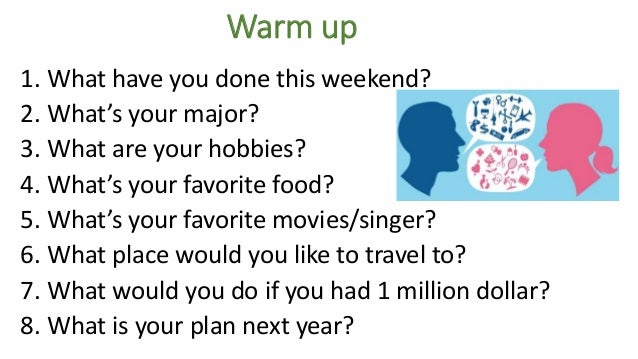
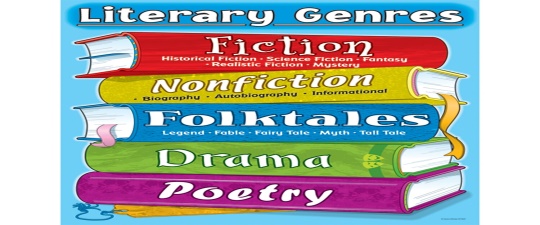

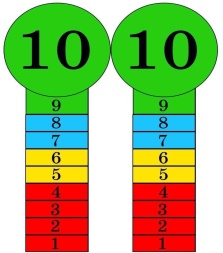





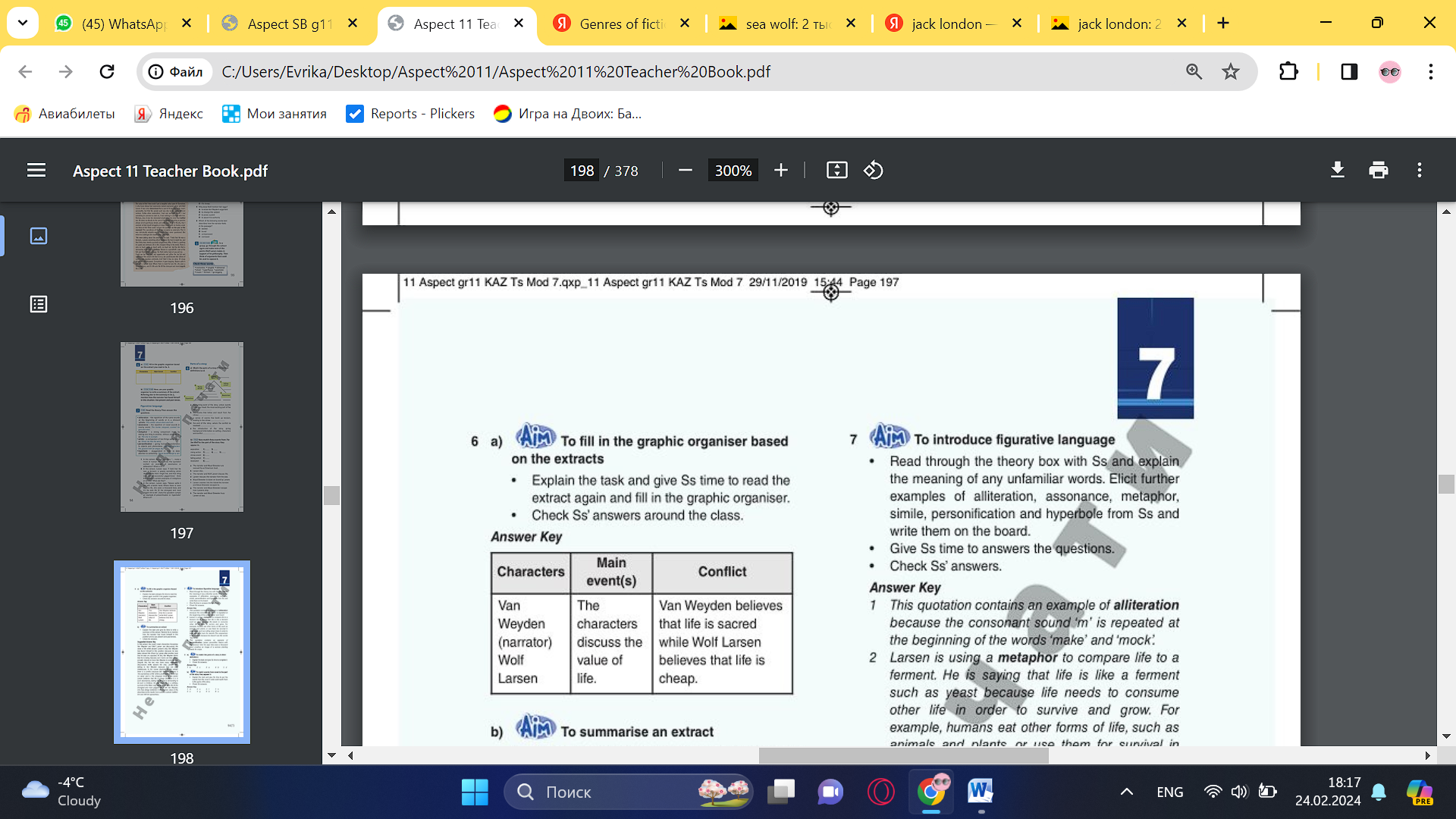 •Pupils
use your graphic organiser to write a summary of the
extract.
•Pupils
use your graphic organiser to write a summary of the
extract.